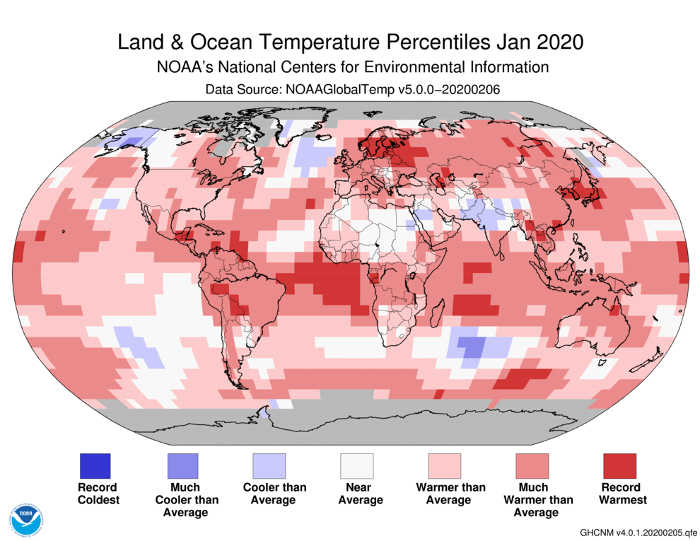- Lake County News reports
- Posted On
January 2020 was Earth’s hottest January on record

What’s more, the temperature departure from average was the highest monthly departure ever recorded without an El Niño present in the tropical Pacific Ocean.
January 2020 marked the 44th consecutive January and the 421st consecutive month with temperatures, at least nominally, above the 20th-century average.
NOAA’s January global climate report found that the global land and ocean surface temperature was the highest on record at 2.05 degrees F (1.14 degrees C) above the 20th-century average. This surpassed the record set in January 2016 by 0.04 of a degree F (0.02 of a degree C).
The four warmest Januaries documented in the climate record have occurred since 2016; the 10 warmest have all occurred since 2002.
Breaking the month down by hemispheres, the Northern Hemisphere also had its warmest January on record, at 2.70 degrees F (1.50 degrees C) above average.
The Southern Hemisphere had a departure of 1.40 degrees F (0.78 of a degree C) above average – its second-warmest January on record after January 2016.
Mapping released with the report showed that it was the fifth-warmest January recorded for the contiguous 48 states, all of which had higher-than-average temperatures, while Alaska was colder.
More notable climate events in the January report:
– Lots of regional heat to go around. Record-warm temperatures were seen across parts of Scandinavia, Asia, the Indian Ocean, the central and western Pacific Ocean, the Atlantic Ocean, and Central and South America. No land or ocean areas had record-cold January temperatures.
– Polar sea ice coverage remained smaller than normal. Arctic sea ice extent (coverage) was 5.3 percent below the 1981-2010 average, tying with 2014 as the eighth-smallest January extent in the 42-year record. Antarctic sea ice coverage during January was 9.8 percent below the average and tied with January 2011 as the 10th smallest.
– Snow cover was lacking. Northern Hemisphere snow coverage was below the 1981-2010 average, having the 18th-smallest January snow cover in the 54-year record.
For a map of the world noting some of the most significant weather climate events that occurred during January 2020, visit here.













